You don’t need a huge room or fancy equipment to create a great media space. With a little planning, even a small corner can become the perfect spot for movies and games—without taking over the rest of your home.
Remember to repin your favorite images!
The best media rooms balance tech with style, so you get a fun entertainment area that still fits in with your home’s vibe.
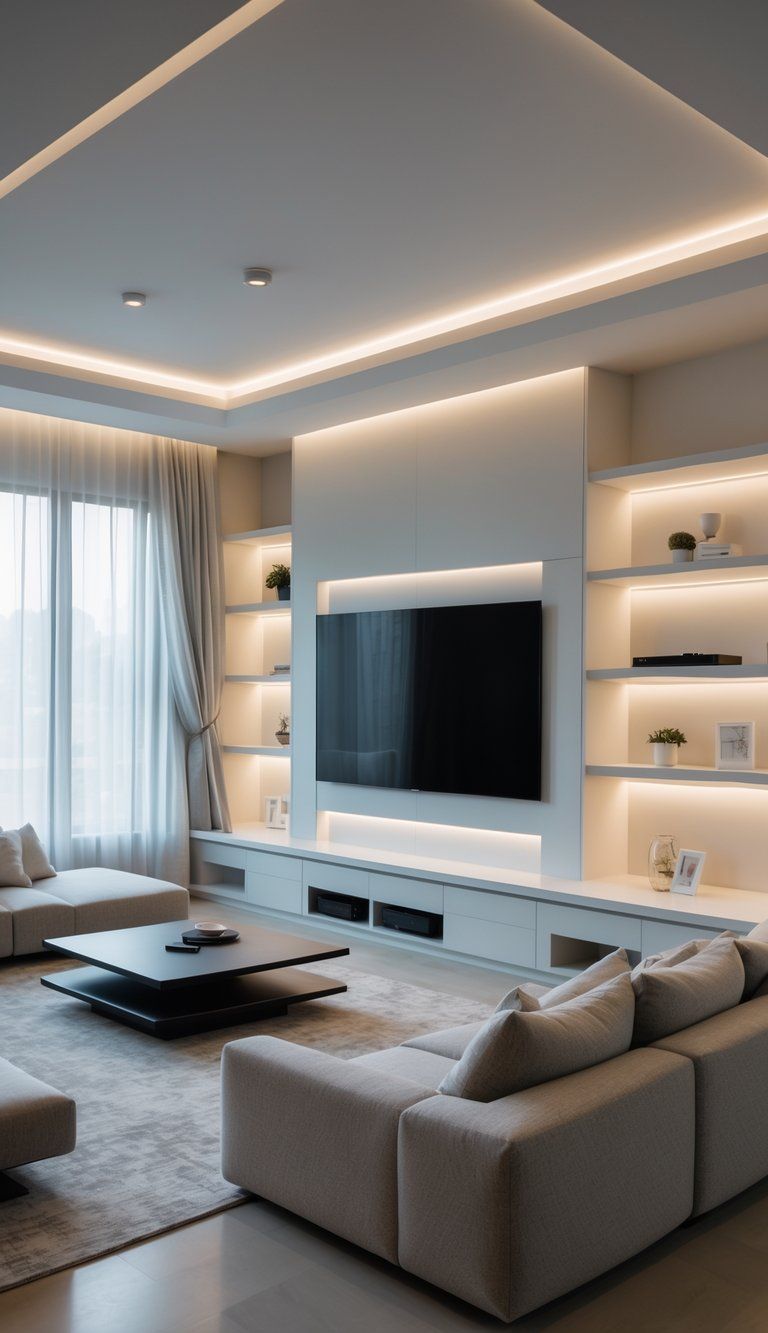
Think about how your media room could do more than just show movies. Some folks hide Murphy beds behind decorative walls or tuck in study nooks so the room stays useful even when the screen’s off.
Built-in shelves can stash speakers and gear while also looking good and saving space.
Smart gadgets make media rooms easier to use and less messy. You can set the mood with automated lighting right from your phone, and good cable management hides those annoying wires.
Simple details like these help your media room blend in, instead of taking over.
Planning Your Media Room for a Balanced Space
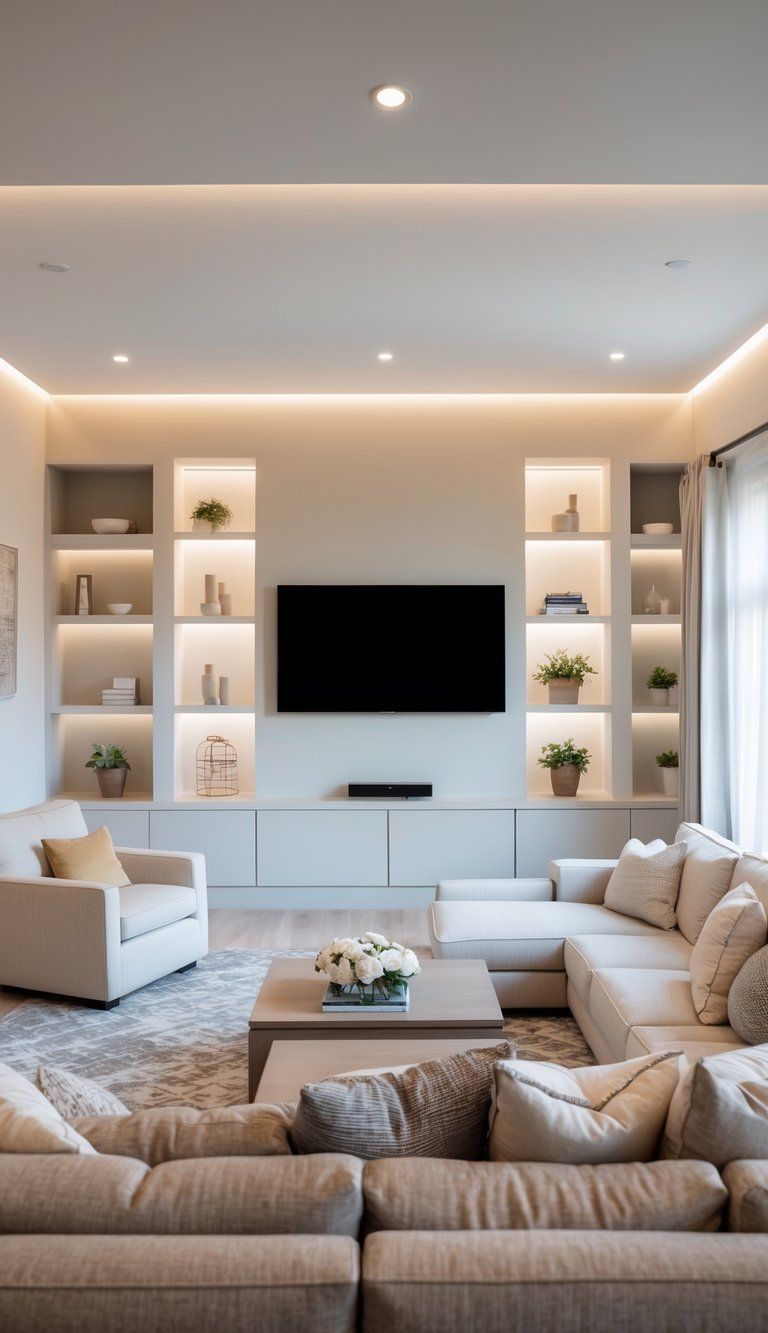
If you want your media room to fit in naturally, you’ll need to plan a bit. The trick is to balance your entertainment needs with your home’s layout and your lifestyle.
Analyzing Your Available Area
Start by grabbing a tape measure and figuring out exactly how much space you’ve got. Small rooms (under 200 square feet) work best with wall-mounted TVs and just the essentials.
If you have 200-300 square feet, you can add more seating or maybe even a projector.
Check your ceiling height—low ceilings might rule out certain projectors. Notice where the windows and doors are, since they can create glare on your screen.
Watch out for built-in shelves, architectural quirks, doorways, or ceiling beams you’ll need to design around.
A multi-functional media room in a small space might use clever furniture like ottomans with storage or wall beds to stay flexible.
Setting Clear Function and Goals
Figure out exactly how you’ll use your media room. Is it for movies, gaming, music, parties, or even work presentations?
Your main purpose will shape your layout and gear choices. Movie lovers might want soundproofing and theater seats, while gamers might care more about storage and super comfy chairs.
Be honest about your budget. Spend on what matters most—maybe killer sound is more important than a giant screen.
If you’re planning to upgrade in stages, add extra outlets or wiring now, so you’re ready later.
Identifying Traffic Flow and Layout Constraints
Sketch out how people will walk through the room. Don’t put seats right in the middle of walkways.
Think about how doors open—make sure they don’t bang into your gear or block the screen.
Everyone should get a good view of the screen without craning their neck. A good rule of thumb: sit about 1.5 to 2.5 times the diagonal size of your screen away from it.
Check where your power outlets, HVAC vents, and internet hookups are. Acoustics matter, too—hard surfaces can bounce sound in weird ways.
If your space does double duty, use area rugs, movable screens, or curtains to split things up when needed. Furniture on wheels makes it easy to switch from movie time to something else.
Built-ins or furniture with hidden storage keep your gear organized and out of sight.
Choosing the Right Location and Layout
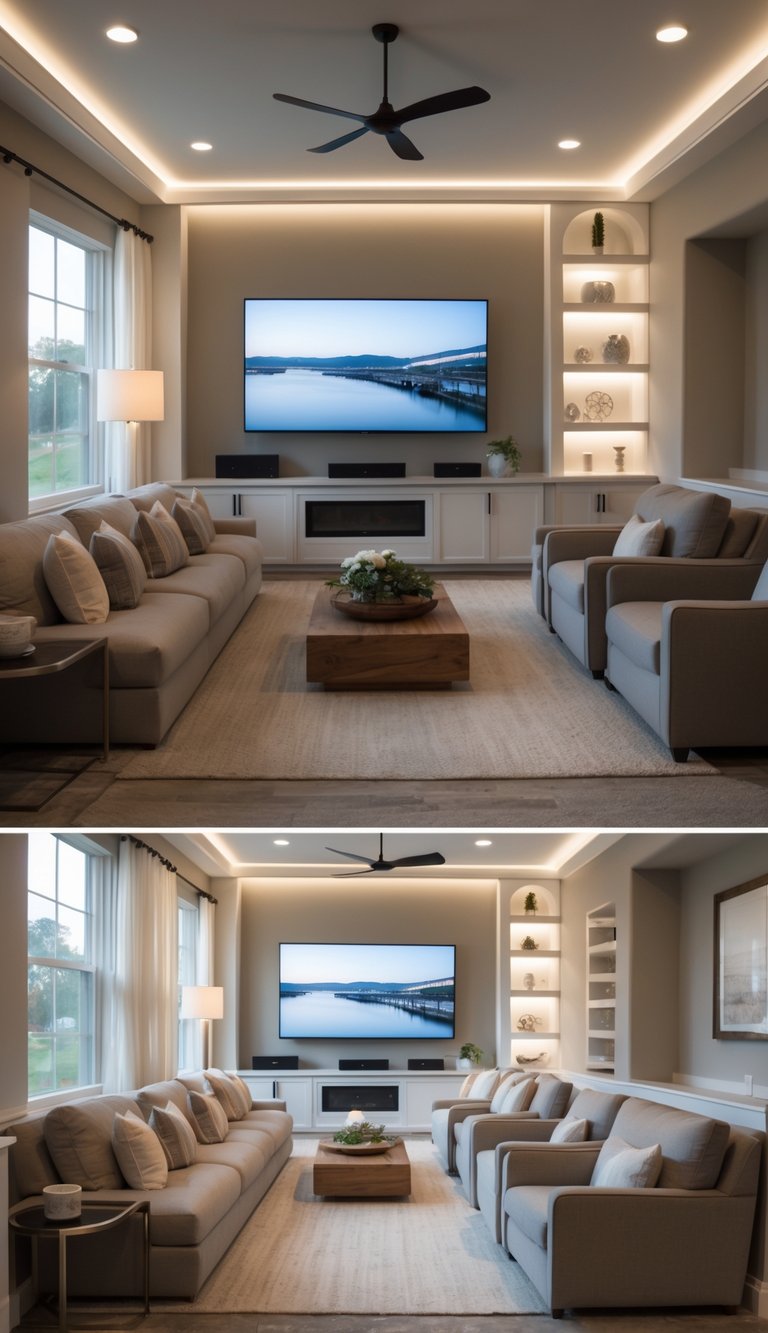
Finding the right spot for your media room means you can enjoy it without letting it take over the whole house. The location should work for your family and make the most of your space.
Selecting the Area for Minimal Disruption
Pick a spot that’s away from the busiest parts of your home. Basements make great media rooms—they’re already quiet and usually don’t have much sunlight to mess with your screen.
No basement? Try to use rooms farther from bedrooms or workspaces. Look for spots with fewer windows, or where you can hang blackout curtains easily.
Sound travels fast in open layouts, so consider acoustic treatments like wall panels or thick curtains to help keep things quiet.
If you have a family, choose a location where people can sleep or work undisturbed when the media room’s in use.
Integrating with Shared Spaces
Most people don’t have a whole room just for media, and that’s totally fine. You can turn your family room into a media space with a few smart choices.
Pick furniture that serves more than one purpose—like ottomans with storage for games and controllers. Sofas and sectionals should work for both chatting and movie marathons.
If your dining area doubles as a media zone, try a drop-down screen that hides away when you’re not watching. Moveable furniture helps too—dining chairs can become extra seats for movie night.
Hidden cabinets keep your gear out of sight, so the room still feels like a living space when you’re not using it for media.
Maximizing Corners and Nooks
Don’t ignore those awkward corners! A cozy corner can make a great mini media zone.
Built-in shelves around a TV save floor space and give you storage. Corner sectionals fit right into the angles and offer plenty of comfy seating.
For a modern look, use wall-mounted gear and floating shelves to keep things tidy and open. If you like a rustic vibe, try framing your TV area with reclaimed wood.
Room dividers—like bookcases or sliding panels—can set off your media space when you need it. Open them up for movie night, close them when you want a more defined room.
Media Room Design Strategies for Minimal Dominance
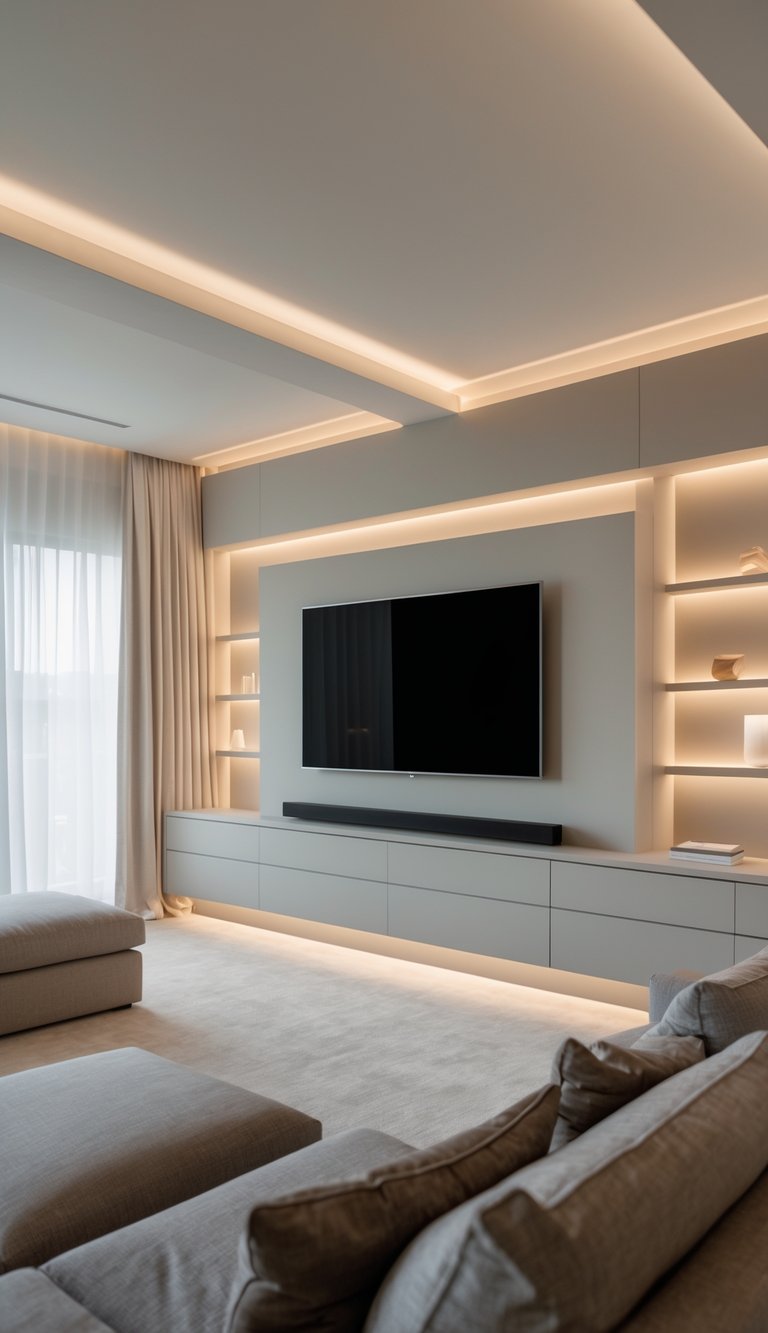
You want your media room to blend in, not stick out. The best setups give you a great viewing experience without making your living area feel like a theater.
Subtle Entertainment Centers
Built-in shelves are a smart way to keep your media setup from taking over. Instead of a huge entertainment center, try wall-mounted options for a sleeker look.
Paint your entertainment unit the same color as the walls so it fades into the background. This makes your TV and gear less noticeable when they’re off.
Floating shelves keep things light and functional. You get space for display, but the room still feels open.
Try a TV frame that turns your screen into art when you’re not watching. Many smart TVs have “art mode” to display photos or paintings instead of a blank screen.
A low-profile media console keeps your components handy but doesn’t draw attention. Look for simple lines and pieces that sit close to the floor.
Disguised Technology and Equipment
You can get projector screens that roll up into the ceiling, so your walls stay clear for art or other decor.
Some speakers double as wall art or decorative pieces. There are lots of stylish options now that don’t look like tech at all.
In-ceiling or in-wall speakers get rid of clutter completely. You still get great sound, but nothing sticks out.
Put remote components in a closet or the next room over. With IR repeaters, you can control everything without seeing a pile of electronics.
Cable management is a lifesaver. Use cord covers that match your walls, or run wires behind the wall for the cleanest look.
Concealed Storage Solutions
Murphy beds behind decorative wallpaper let your media room double as a guest space. It’s a clever way to get more use out of one room.
Built-in cabinets with stylish doors hide your media gear and add a touch of design. Pick panels that go with your room’s theme.
Drawers in your media furniture keep remotes and controllers out of sight but easy to find. Look for pieces made for media storage.
Ottomans with storage are great for blankets and pillows when it’s movie night. You get comfort without the mess.
Decorative baskets on shelves offer storage that looks intentional. Toss in anything you need handy during a movie or game session.
Selecting Functional and Comfortable Furniture
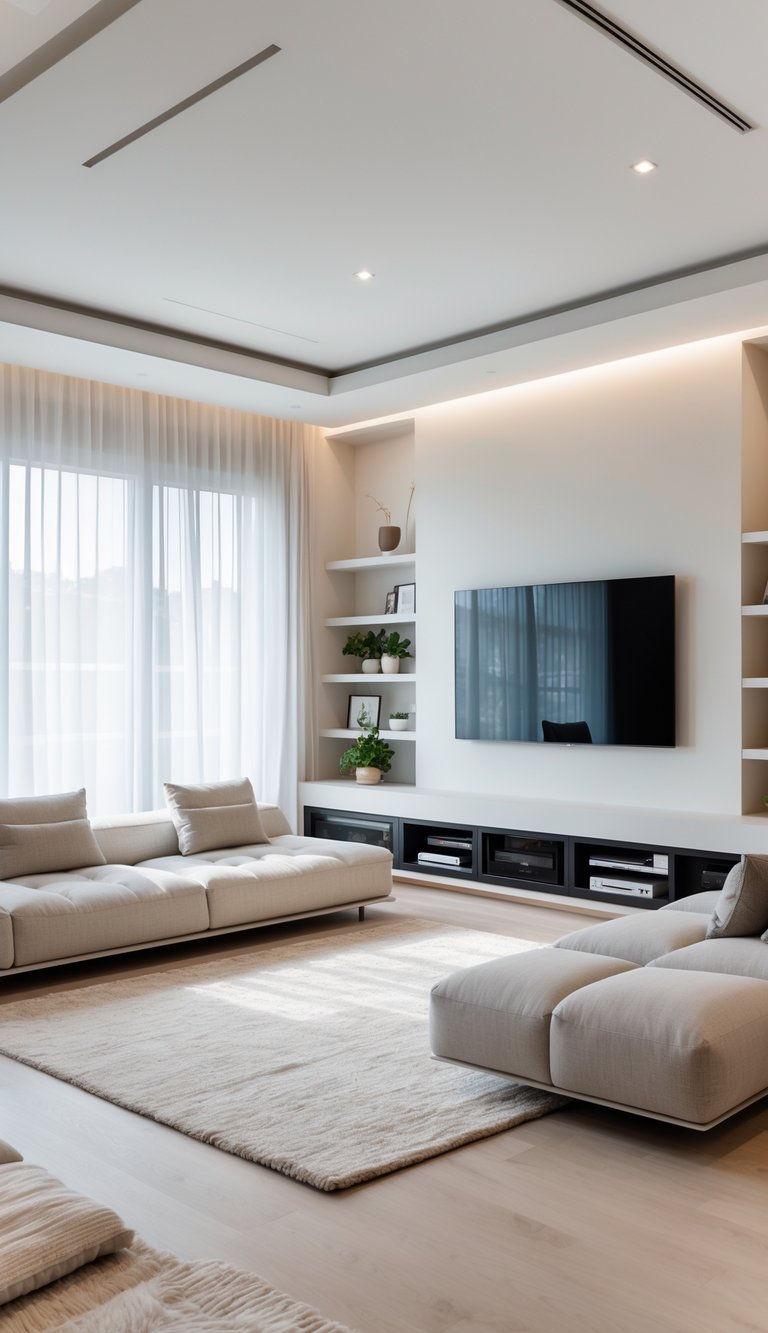
The right furniture can totally change how your media room feels and works. Your choices here really set the tone for the space.
Multi-Purpose Seating Options
Pick seating that does more than one job. A sectional sofa gives you lots of seats and creates a cozy spot for conversation.
Many modern sectionals come with built-in USB ports, hidden storage, or reclining seats for extra comfort.
If you’ve got a bigger room, a U-shaped sectional makes a great viewing area and still lets people chat when the TV’s off.
For smaller spaces, modular pieces are your friend. You can rearrange them whenever you want.
Bean bags and floor pillows add flexible seating that you can stash away easily. They’re perfect for kids or extra guests.
Stick to durable, stain-resistant fabrics like microfiber or performance weaves—they stand up to spills and heavy use.
Scale and Proportion for Smaller Spaces
In tight rooms, scale down your furniture. Go for slim, streamlined pieces instead of big, bulky ones.
Wall-mounted TV units free up floor space. Floating shelves hold your gear but keep the room open.
Try these space-saving options:
- Apartment-sized sofas (72-84 inches wide)
- Love seats with accent chairs
- Wall-hugging recliners that only need a few inches behind them
Always measure before you buy, and sketch out a floor plan to see what fits. Leave at least 30 inches for walkways so the room doesn’t feel cramped.
Light-colored furniture can make a small space feel bigger. Pieces with legs help, too—you can see more floor, and the room feels airier.
Incorporating Ottomans and Accent Furniture
Ottomans really are the unsung heroes here. Use them as coffee tables, extra seats, or footrests.
Look for ottomans with hidden storage, firm tops for trays, and tough, easy-to-clean fabrics.
Nesting tables are handy for snacks and drinks. Spread them out for movie night, then tuck them away.
A slim console table behind the sofa gives you a spot for lamps or drinks without crowding the room.
Side tables with charging ports keep your devices powered up. Pick ones with built-in USB or wireless charging to cut down on cord mess.
Lighting Solutions for Ambience and Subtlety
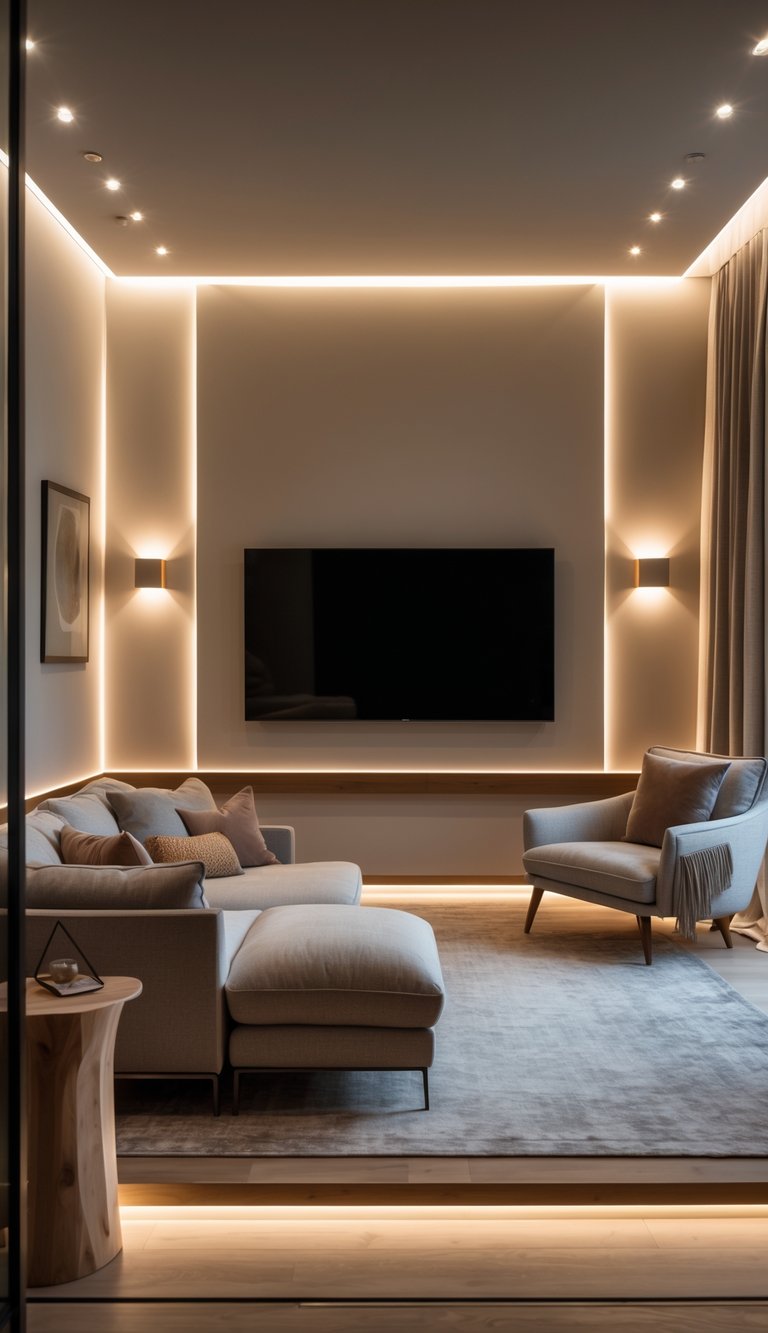
Good lighting can totally change your media room, making it feel special without taking over. The right mix of lights sets the mood and keeps the space practical.
Ambient and Accent Lighting Choices
Ambient lighting sets the tone for your space. Instead of bright ceiling lights that cause glare, try soft lighting that helps your eyes adjust.
Dimmer switches on main lights let you tweak the brightness easily.
Wall sconces at eye level give off a warm glow and look stylish, too. They’re just bright enough for moving around without messing up your movie.
Recessed lights with dimmers work well in multi-use rooms. Install them around the edges instead of right over the TV to cut down on reflections.
Floor lamps with upward-facing shades bounce light off the ceiling, creating gentle, even lighting without harsh shadows or glare.
Harnessing Natural Light with Blackout Curtains
Natural light really brightens up a media room for everyday stuff, but honestly, it can wash out your screen when you’re watching during the day. Blackout curtains let you control how much light comes in, so you don’t have to worry about glare.
Look for curtains that block out all the light—100% if possible. Good blackout curtains also help dampen sound, which definitely improves the acoustics.
Motorized blackout curtains make life easier. Just hit a button on your remote and the room goes dark. Some systems even sync up with your media devices, which is a nice touch.
When you’re not watching anything, pull the curtains back and let that natural light flood in. This flexibility makes your media room useful all day, not just for movie nights.
Integrating LED Strip Lighting
LED strip lighting gives your room a modern vibe and is pretty practical, too. Stick some strips behind your TV for bias lighting—it helps with eye strain and makes the picture look better, especially in the dark.
You can also run LED strips under shelves or cabinets to highlight your stuff without creating annoying glare. Pick strips where you can adjust the brightness and color temperature, so you can easily set the mood.
LED Strip Placement Ideas:
- Behind the TV (bias lighting)
- Under furniture edges
- Around doorways or along baseboards
- Inside display cabinets
Control smart LED systems with your phone or tie them into your home automation setup. You can set up scenes like “Movie Night” or “Game Time” with just one tap.
Go for warm white LEDs (2700K-3000K) for a cozy atmosphere, or pick cool white (4000K-5000K) if you want things to feel more energetic. If you like a little fun, color-changing strips let you switch things up for different activities.
Acoustics and Sound Management Without Overpowering
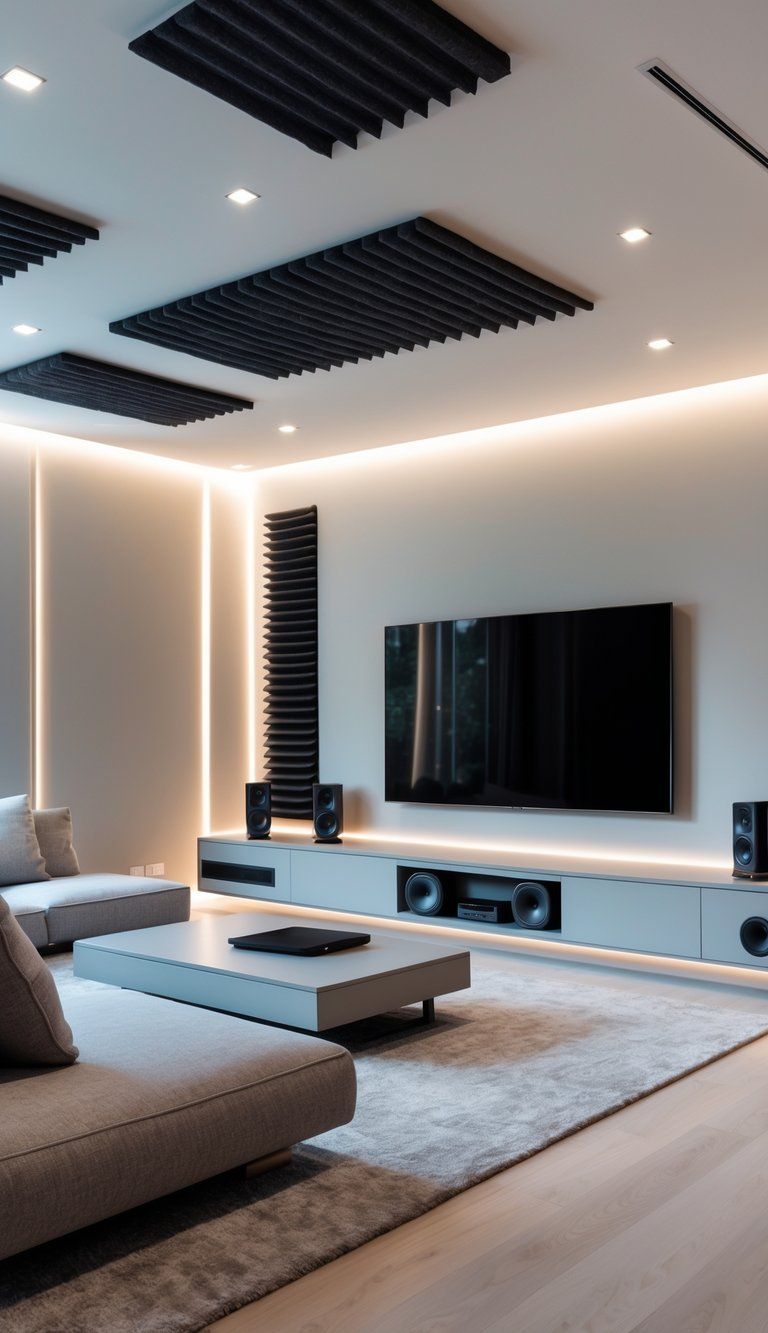
You can create a media room with great sound without making it look like a recording studio. Choose smart acoustic solutions that blend in with your decor while still giving you that immersive audio experience.
Sound-Absorbing Materials and Panels
Sound-absorbing materials help control echoes and make audio clearer. Acoustic panels don’t have to be ugly—these days, you can find options that double as art.
Try some of these ideas:
- Fabric-wrapped acoustic panels in custom prints and colors
- Acoustic ceiling tiles that look like part of your design
- Bookshelf placement along the walls to soak up sound
- Soft furnishings like plush rugs, curtains, and upholstered furniture
You can add sound-absorbing materials during regular decorating updates. For example, hang thick curtains or lay down a big area rug to boost acoustics and style at the same time.
Optimizing Speaker Placement
Where you put your speakers matters—a lot. Good placement improves sound quality without filling the room with visible gear.
Ideal speaker positions for a 5.1 system:
- Center speaker: Put it right above or below your screen
- Front speakers: At ear level when you’re seated, making a triangle with your seat
- Surround speakers: A bit above ear level, on the sides or rear walls
- Subwoofer: The corner usually works best for bass
In-wall or in-ceiling speakers give you great sound without being obvious. You can even paint them to match your walls.
Wireless speakers have come a long way. They cut down on messy cables and let you move things around as needed.
Blending Surround Sound into Design
You can integrate a surround sound system without your room turning into a tech showroom. Modern gear can actually look good with your decor.
Try these tricks:
- Built-in cabinetry for housing components that match your style
- Speaker covers in colors that blend in
- Cable management with paintable raceways
Control everything from your phone or tablet, thanks to smart home tech. No more hunting for a pile of remotes.
How you arrange furniture matters, too. Set up your seating for a “sweet spot” in the middle, but keep things natural for conversation when you’re not watching something.
Decor and Color Schemes That Complement Your Home
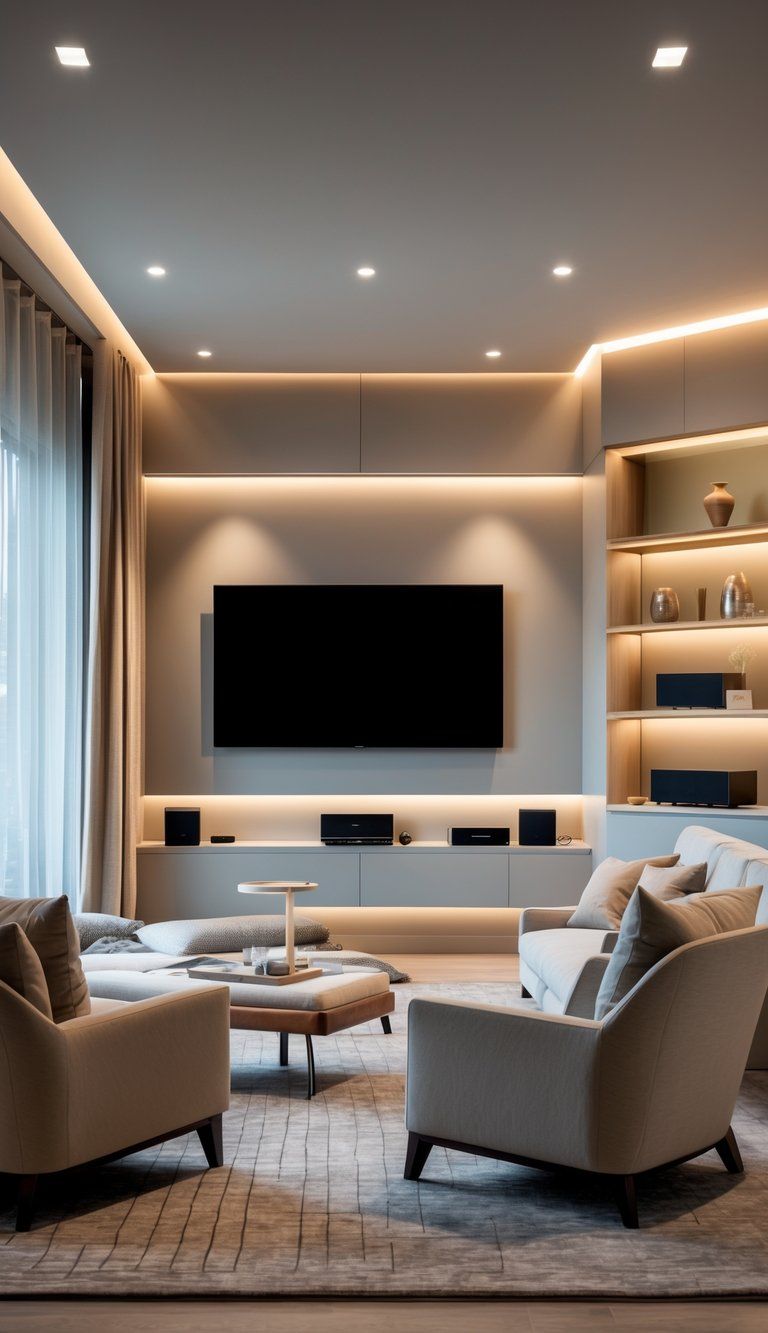
Your media room should feel like part of your home, not some random add-on. The right colors and decor help blend your tech with the rest of your space.
Introducing an Accent Wall
An accent wall adds visual interest without taking over. Go for a darker shade behind your TV to help the screen stand out and reduce eye strain. Navy blue, charcoal gray, or deep green usually look good.
If your room is small, just paint the TV wall a dark color and leave the rest lighter. That way, you get the effect without making the room feel tiny.
Not sure about committing to paint? Try peel-and-stick wallpaper. Textured options like grasscloth or subtle patterns can add depth without fighting with your screen.
A wooden accent wall is another cool idea. It adds warmth and helps with sound, so your movies sound better, too.
Selecting a Harmonious Color Scheme
Pick a color scheme that connects with nearby spaces. Look at the colors you already have at home and choose shades that fit in, instead of starting from scratch.
The 60-30-10 rule helps balance things out:
- 60% main color (walls, big furniture)
- 30% secondary color (curtains, accent chairs)
- 10% accent color (art, accessories)
Neutrals like gray, taupe, and soft white make a great backdrop and don’t compete with your screen. They also help your tech blend in when it’s off.
For trim and ceilings, stick with white or light neutrals to keep things bright and contrast with darker walls.
Layering Throw Pillows and Soft Textiles
Textiles bring comfort and help with sound, too. Start with throw pillows in different sizes and textures that match your color palette. Mix up solids and subtle patterns for a little variety.
A soft area rug helps absorb sound and grounds the room. Go with a low-pile, darker rug to hide any spills from movie snacks.
Window treatments should control light and help with acoustics. Blackout curtains in a color that matches your walls cut glare and improve sound.
Toss in a few cozy throws—wool, cotton, or velvet in coordinating shades. They look inviting and are perfect for chilly movie nights.
Subtle Personalization and Media-Inspired Touches
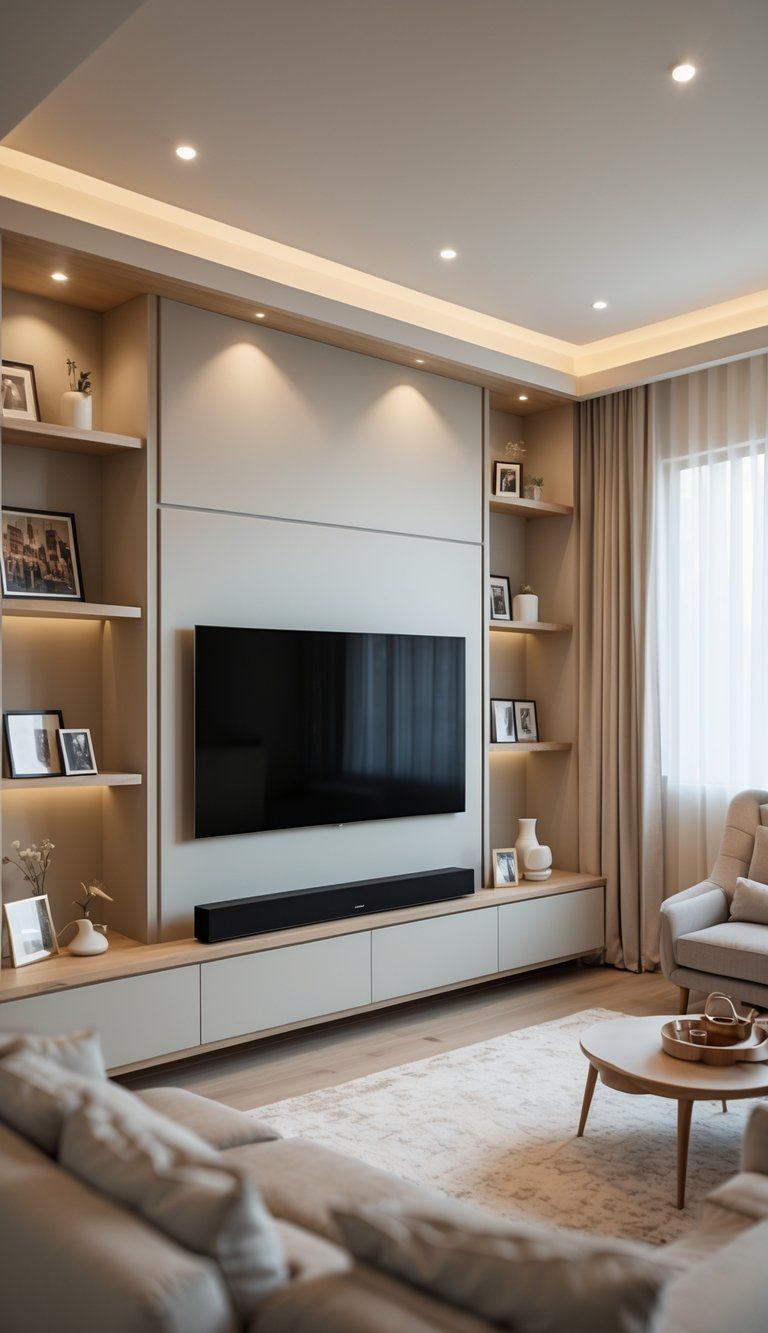
Your media room should show off your style and love for movies, but it doesn’t need to go overboard. Thoughtful details make the room feel special and balanced.
Curating Framed Art and Movie Posters
You don’t need huge, flashy movie posters to make an impact. Pick vintage or artistic film posters that actually fit your design.
Frame them in sleek, matching frames for a gallery wall vibe. It instantly upgrades your memorabilia from college dorm to grown-up space.
If you want to keep it subtle, try abstract art inspired by your favorite films or black-and-white stills from classics. These pieces spark conversation without screaming “home theater.”
Mix in personal photos or other art to avoid a theme overload. Usually, a gallery wall with three to five pieces looks best in a smaller room.
Adding Nods to Movie Night Traditions
Little touches can nod to movie traditions without taking over. Maybe add a shelf for displaying vintage ticket stubs or film reels—instant conversation starters.
Grab throw blankets in classic theater colors like burgundy or navy for comfort and a subtle nod to old-school theater aesthetics. Toss them in a decorative basket so they’re easy to grab.
Custom coasters with movie quotes or simple film references are both fun and practical. They keep your tables safe and add personality.
Add some dimmable table lamps or wall sconces for ambiance. You don’t need a complicated lighting install to get that cozy movie-night glow.
Integrating a Small Popcorn Machine
A compact popcorn machine brings some fun and nostalgia, and it doesn’t need much space. Look for countertop models under a foot tall that you can stash away when you’re done.
Set your popcorn maker on a rolling cart or a small shelf that fits your style. It creates a mini-concession stand without eating up seating space.
Pick a machine in a color that matches your decor—brushed steel for a modern look or vintage red for something classic. Some newer ones run quietly, so you won’t miss any dialogue.
Keep small, matching bowls nearby for serving. Clear glass or neutral ceramics work for most designs and don’t distract from your other decor.
Integrating Technology Seamlessly
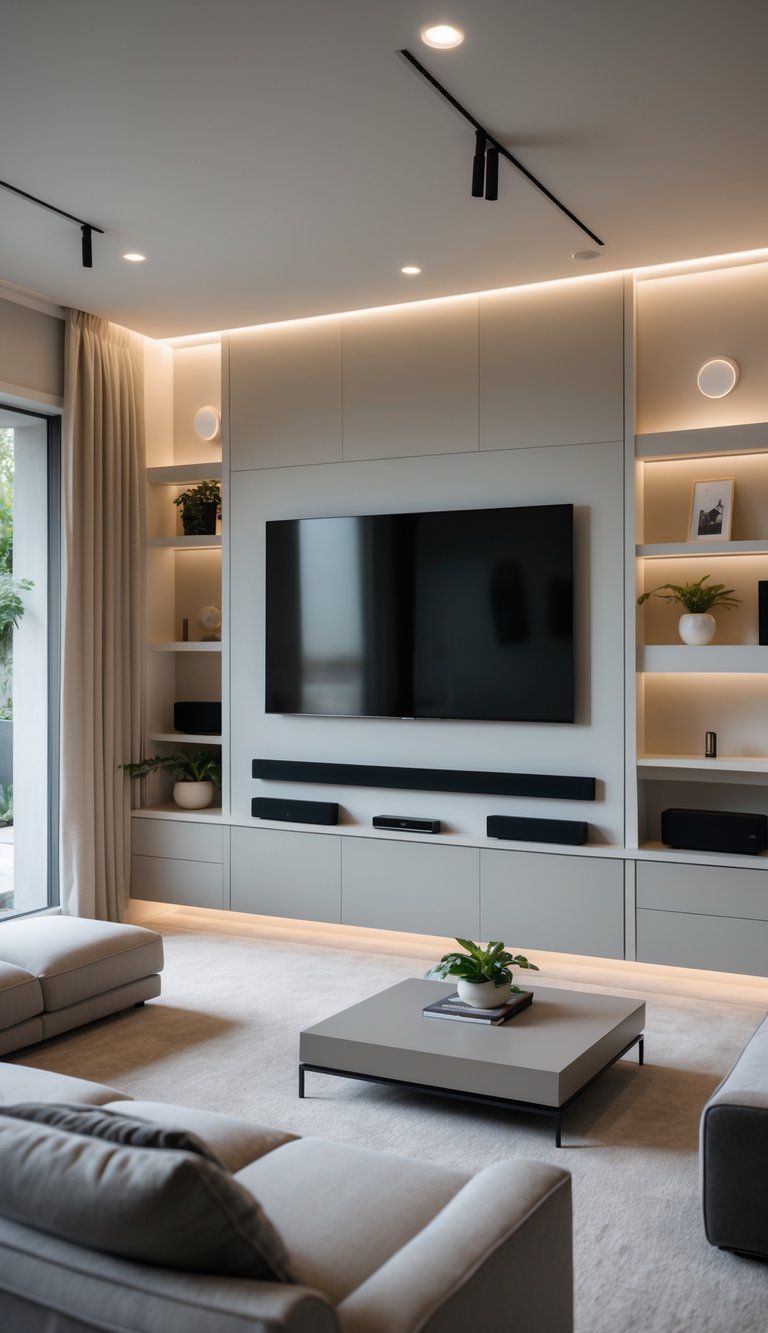
Modern media rooms need tech that works well but doesn’t take over the whole space. The trick is to hide your gear while keeping everything easy to use.
Minimizing Visual Impact of Home Theater
Mount your TV on the wall for a clean look. Choose a slim model that hugs the wall, or try a TV that doubles as art when it’s off. Some can display paintings or photos in standby mode, which is pretty slick.
If you use a projector, check out ceiling-mounted options that retract when you’re done. Motorized screens can disappear into the ceiling or a custom cabinet.
Speakers don’t have to stick out. In-wall or in-ceiling speakers sound great and don’t eat up floor space. If you like stand-alone speakers, pick ones that actually fit your style.
Hide cables with cord covers, raceways, or run them through the walls. It’s a small detail, but it makes a huge difference in how polished your media room looks.
Discreet Streaming Device Setups
Streaming devices keep shrinking and getting more powerful. You can just tuck most modern streaming sticks behind your TV, so you don’t have to see any hardware at all.
Try using an entertainment console with closed storage if you’ve got bigger stuff like receivers or gaming systems. Furniture with built-in cable management really helps keep the mess down.
Smart home hubs let you control your whole media setup with your voice or a quick tap on your phone. That way, you don’t have to deal with a pile of remotes every time you want to watch something.
Smart Home Integration Tips:
- Grab a universal remote or use an app so you can manage everything from one place.
- Set up smart lighting that automatically dims when it’s time for a movie.
- Make custom scenes that tweak your sound, picture, and lights all at once.
Don’t forget about ventilation—electronics need to breathe. Go for furniture with mesh backing, or maybe install a tiny fan if your gear lives in a closed cabinet.

